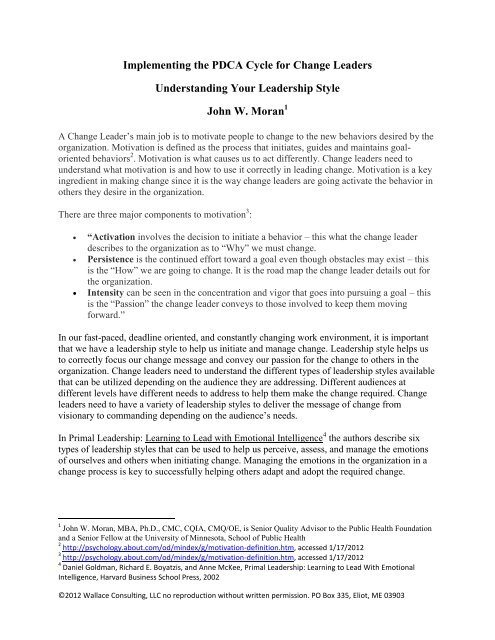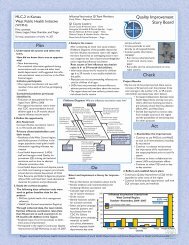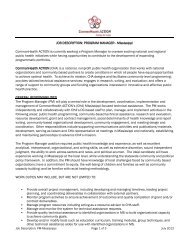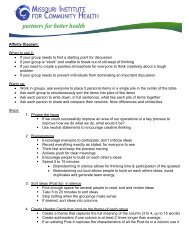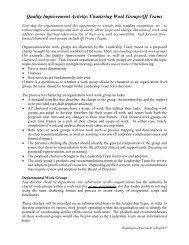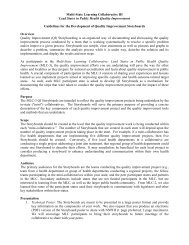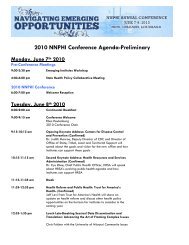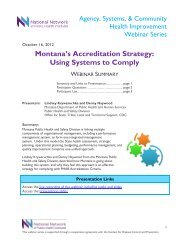Understanding Your Leadership Style - Public Health Foundation
Understanding Your Leadership Style - Public Health Foundation
Understanding Your Leadership Style - Public Health Foundation
You also want an ePaper? Increase the reach of your titles
YUMPU automatically turns print PDFs into web optimized ePapers that Google loves.
Implementing the PDCA Cycle for Change Leaders<br />
<strong>Understanding</strong> <strong>Your</strong> <strong>Leadership</strong> <strong>Style</strong><br />
John W. Moran 1<br />
A Change Leader’s main job is to motivate people to change to the new behaviors desired by the<br />
organization. Motivation is defined as the process that initiates, guides and maintains goaloriented<br />
behaviors 2 . Motivation is what causes us to act differently. Change leaders need to<br />
understand what motivation is and how to use it correctly in leading change. Motivation is a key<br />
ingredient in making change since it is the way change leaders are going activate the behavior in<br />
others they desire in the organization.<br />
There are three major components to motivation 3 :<br />
<br />
<br />
<br />
“Activation involves the decision to initiate a behavior – this what the change leader<br />
describes to the organization as to “Why” we must change.<br />
Persistence is the continued effort toward a goal even though obstacles may exist – this<br />
is the “How” we are going to change. It is the road map the change leader details out for<br />
the organization.<br />
Intensity can be seen in the concentration and vigor that goes into pursuing a goal – this<br />
is the “Passion” the change leader conveys to those involved to keep them moving<br />
forward.”<br />
In our fast-paced, deadline oriented, and constantly changing work environment, it is important<br />
that we have a leadership style to help us initiate and manage change. <strong>Leadership</strong> style helps us<br />
to correctly focus our change message and convey our passion for the change to others in the<br />
organization. Change leaders need to understand the different types of leadership styles available<br />
that can be utilized depending on the audience they are addressing. Different audiences at<br />
different levels have different needs to address to help them make the change required. Change<br />
leaders need to have a variety of leadership styles to deliver the message of change from<br />
visionary to commanding depending on the audience’s needs.<br />
In Primal <strong>Leadership</strong>: Learning to Lead with Emotional Intelligence 4 the authors describe six<br />
types of leadership styles that can be used to help us perceive, assess, and manage the emotions<br />
of ourselves and others when initiating change. Managing the emotions in the organization in a<br />
change process is key to successfully helping others adapt and adopt the required change.<br />
1 John W. Moran, MBA, Ph.D., CMC, CQIA, CMQ/OE, is Senior Quality Advisor to the <strong>Public</strong> <strong>Health</strong> <strong>Foundation</strong><br />
and a Senior Fellow at the University of Minnesota, School of <strong>Public</strong> <strong>Health</strong><br />
2 http://psychology.about.com/od/mindex/g/motivation-definition.htm, accessed 1/17/2012<br />
3 http://psychology.about.com/od/mindex/g/motivation-definition.htm, accessed 1/17/2012<br />
4 Daniel Goldman, Richard E. Boyatzis, and Anne McKee, Primal <strong>Leadership</strong>: Learning to Lead With Emotional<br />
Intelligence, Harvard Business School Press, 2002<br />
©2012 Wallace Consulting, LLC no reproduction without written permission. PO Box 335, Eliot, ME 03903
<strong>Leadership</strong> <strong>Style</strong> When To Use it What Does It Do?<br />
Visionary<br />
To create a new vision or<br />
direction<br />
Motivates people towards a<br />
shared vision of change<br />
Coaching<br />
To help people improve their<br />
skills and performance<br />
Aligns individual goals with the<br />
organization’s goals<br />
Affiliative<br />
To motivate people during Builds harmonious relations<br />
difficult times<br />
Democratic<br />
To reach agreements through<br />
consensus<br />
Obtains input, commitment, and<br />
participation of those involved in<br />
a change<br />
Pacesetting<br />
To motivate people to reach a Helps achieve stretch goals<br />
challenging deadline<br />
Commanding To quickly resolve a crisis Helps to get out of an emergency<br />
Each leadership style has it time and place in an organization but just using one style all the time as a<br />
change leader will not reach all the people involved in the change. As a change leader you must use the<br />
different styles to increase your effectiveness in making change. What works for one group may not be<br />
appropriate for another. You must “observe and listen” to determine which one is right for your audience.<br />
Rate yourself on the following scale as to how often you use the six leadership styles and describe a<br />
recent example of the usage.<br />
(1) – Never used, (2) – Rare occasion, (3). – Occasionally, (4) – Regularly (most comfortable)<br />
<strong>Leadership</strong> <strong>Style</strong> When To Use it What Does It Do? Rating of<br />
leadership <strong>Style</strong><br />
Usage<br />
Visionary<br />
Coaching<br />
Affiliative<br />
Democratic<br />
Pacesetting<br />
Commanding<br />
To create a new<br />
vision or direction<br />
To help people<br />
improve their skills<br />
and performance<br />
To motivate people<br />
during difficult times<br />
To reach agreements<br />
through consensus<br />
To motivate people to<br />
reach a challenging<br />
deadline<br />
To quickly resolve a<br />
crisis<br />
Motivates people<br />
towards a shared<br />
vision of change<br />
Aligns individual<br />
goals with the<br />
organization’s goals<br />
Builds harmonious<br />
relations<br />
Obtains input,<br />
commitment, and<br />
participation of those<br />
involved in a change<br />
Helps achieve stretch<br />
goals<br />
Helps to get out of an<br />
emergency<br />
Recent<br />
Example<br />
Using these leadership styles appropriately requires a combination of self-awareness, self-management,<br />
social awareness, and relationship management skills. <strong>Understanding</strong> and utilizing these leadership<br />
styles at the appropriate time and place will optimize your performance as a change leader to motivate<br />
and activate others to change.<br />
©2012 Wallace Consulting, LLC no reproduction without written permission. PO Box 335, Eliot, ME 03903


